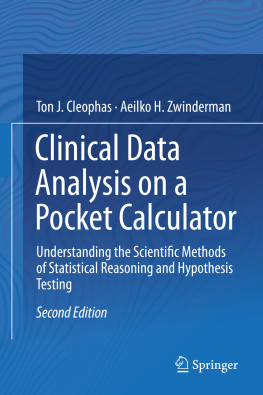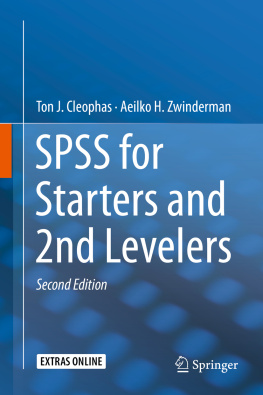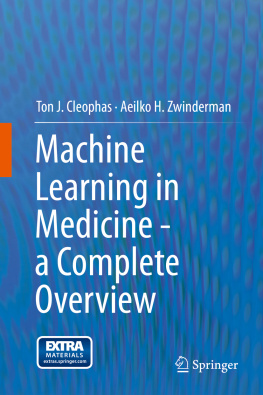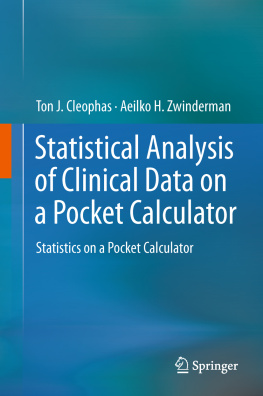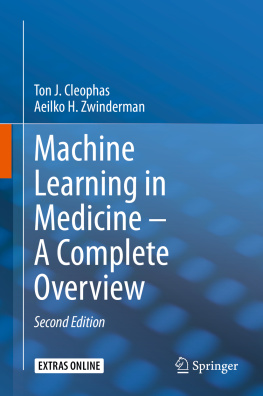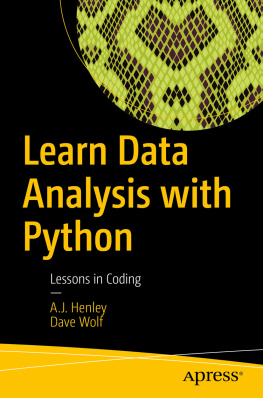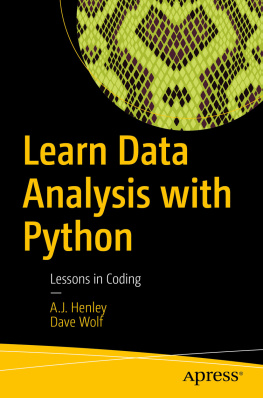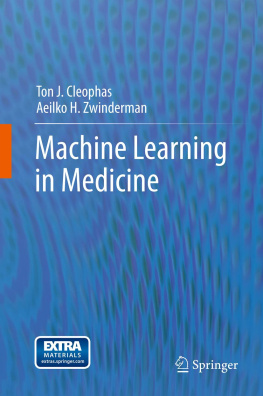Springer International Publishing Switzerland 2016
Ton J. Cleophas and Aeilko H. Zwinderman Clinical Data Analysis on a Pocket Calculator 10.1007/978-3-319-27104-0_1
1. Data Spread, Standard Deviations
General Purpose
Repeated measures have a central tendency (averages, two averages, regression lines), and a tendency to depart from the expected central values. In order to estimate the magnitude of the departures from the averages an index is needed. Why not simply add-up departures? However, this does not work, because generally the values higher and lower than the averages tend to even out, and the results would be zero. A pragmatic solution was taken by statisticians around the world. They decided to square the departures first, and then add-up. The add-up sum of the squared departures is called the variance. The square root of the variance is called the standard deviation. This chapter shows how pocket calculators can be used for computa tion of standard deviations.
Schematic Overview of Type of Data File
Primary Scientific Question
Is the standard deviation an adequate index for spread in the data?
Data Example
Standard deviations (SDs) are often used for summarizing the spread of the data from a sample. If the spread in the data is small, then the same will be true for the standard deviation. Underneath the calculation is illustrated with t he help of a data example.
|
|
|
|
|
|
|
+ |
Mean | . | => | /8 = 53.375 |
SD= |
| (55-53.375)2 |
| (54-53.375)2 |
| (51-53.375)2 |
| (55-53.375)2 |
| (53-53.375)2 |
| (53-53.375)2 |
| (54-53.375)2 |
| (52-53.375) 2+ |
SD= | => .. / (n-1) => .=> 1.407885953 |
Calculate Standard Deviations
Each scientific po cket calculator has a mode for data-analysis. It is helpful to calculate in a few minutes the mean and standard deviation of a sample.
Calculate standard deviation: mean = 53.375 SD = 1.407885953
The next steps are required:
Casio fx-825 scientific
On .mode....shift.AC.55.M+.54.M+.51.M+.55.M+.53.M+.53..M+.54.M+.52.M+.shift[x].shift.xn-1
------
Texas TI-30 scientific
On.55.+.54.+.51.+.55. +.53.+.53.+....54. +.52.+.2nd.x.2nd.xn-1
------
Sigma AK 222 and Commodoor
On 2ndf on 55 M+ 54 M+ 51 M+ 55 M+ 53 M+ 53 M+ 54 M+ 52 M+ x=>M MR
------
Calcu lator: Electronic Calculator
On.mode.2.55.M+.54.M+.51.M+.55.M+.53.M+.53....M+.54.M+.52.M+.Shift.S-var.1.=.(mean).Shift.S-var. 3.(sd)
Conclusion
Repeated measures have a central tendency and tendency to depart from the expected central values. In order to estimate the magnitude of the departures from the averages an index is needed. The add-up sum of the squared departures is used for the purpose, and is called the variance. The square root of the variance is called the standard deviation. This chapter shows how pocket calculators can be used for computation of standard deviations. Sometimes, data files are skewed, and mean values do not mean too much. Instead the modus (the frequentest value) or the median (the value in the middle) are more meaningful (see Chap. ).
Example:
What is the mean value, what is the SD?
Note
More backgro und, theoretical and mathematical information of means, variances, standard deviations, and standard errors (of the mean) is given in Statistics applied to clinical studies 5th edition, Chap. , Springer Heidelberg Germany, 2012, from the same authors.
Springer International Publishing Switzerland 2016
Ton J. Cleophas and Aeilko H. Zwinderman Clinical Data Analysis on a Pocket Calculator 10.1007/978-3-319-27104-0_2
2. Data Summaries, Histograms, Wide and Narrow Gaussian Curves
General Purpose
In order to summari ze continuous data, either histograms can be plotted or Gaussian curves can be drawn. This chapter is to assess how to summarize your data with the help of a pocket calculator.
Schematic Overview of Type of Data File
Primary Scientific Question
How can histograms, otherwise called frequency distributions, and wide and narrow Gaussian curves be used for summarizing continuous data?
Hypothesized Data Example
Based on the same data, but with different meaning. The wide one summarizes the data of our trial. The narrow one summarizes the mean of many trials similar to our trial. It can be mathematically proven that this is so.
Continuous data can be plotted in the form of a histogram (upper graph). The upper graph is assumed to present individual cholesterol reductions after one week drug treatment in 1000 patients. The bar in the middle is observed most frequently. The bars on either side grow gradually shorter. The graph, thus, pretty well exhibits two main characteristics of your data namely the place of the mean and the distribution of the individual data against the mean. On the x-axis, frequently called z-axis in statistics, it has individual data. On the y-axis it has how often. This graph adequately represents the data. It is, however, not adequate for statistical analyses. The lower graph pictures a Gaussian curve, otherwise called normal (distribution) curve. On the x-axis we have, again, the individual data, expressed either in absolute data or in SDs (standard deviations) distant from the mean. See Chap. for calculation information of SDs. On the y-axis the bars have been replaced with a continuous line. It is now impossible to determine from the graph how many patients had a particular outcome. Instead, important i nferences can be made. For example, the total area under the curve (AUC) represents:

